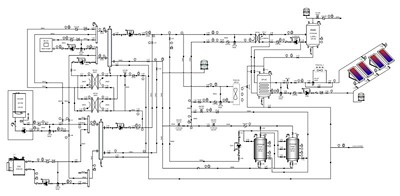Pilot Plant Control of Heating Systems Using NI LabVIEW and NI CompactRIO
Edorta Carrascal Lecumberri, Universidad del País Vasco (UPV/EHU)
"The modularity of LabVIEW in our plant gives us great versatility in the system because we can easily adapt it to the different test requirements. This is critical because the equipment of the plant is in constant evolution."
- Edorta Carrascal Lecumberri, Universidad del País Vasco (UPV/EHU)
The Challenge:
Developing a versatile control system to operate a pilot plant to test heating systems in buildings, providing realistic experimental testing and simulation of current and future energy technologies.
The Solution:
Using NI LabVIEW to integrate different system components, including data collection and storage, data processing, controllers, and communication with other software in a single, real-time environment.
Author(s):
Edorta Carrascal Lecumberri - Universidad del País Vasco (UPV/EHU)
Izaskun Garrido Hernández - Universidad del País Vasco (UPV/EHU)
Iker González Pino - Universidad del País Vasco (UPV/EHU)
José María Sala Lizarraga - Universidad del País Vasco (UPV/EHU) | Laboratorio de Control de la Calidad en la Edificación (LCCE) del Gobierno Vasco
To meet the quality assurance standards of the Department of Housing, Public Works, and Transport, the Thermal Department at the LCCE of the Basque government certifies the thermal behavior of materials and construction elements. This system results in product improvements and general support for both designers and developers to ensure regulatory compliance with thermal requirements, as well as to contribute to building research and development.
Due to the new construction requirements derived from the application of EU law and its further development, we took a step toward improving the energy efficiency in buildings and the gradual introduction of renewable energies. We set up an experimental facility to test energy installation technologies that we will integrate with the building sector in the coming years.
System Installation
The equipment in our LCCE experimental installation is organized into four main modules: high-temperature generation, low-temperature generation, thermal storage, and power consumption.
To generate high temperatures (up to 90 °C), we integrated an internal combustion engine (a microcogeneration unit), a conventional boiler, a Stirling engine, and a system of solar collectors. To generate low temperatures (up to 50 °C), we used a heat pump with condensation by air and axial fans. The thermal storage module is composed of two inertial tanks (1,000 liters each), one of which is stratified. The heat dissipating module is a fan coil unit.
The modules can work individually or combined with a heat sink to simulate the energy demand under a given consumption evolution curve. The system must control the plant to satisfy this demand, which is determined based on parameters associated with the building characteristics. There are more than 60 items to monitor through temperature sensors, flow meters, and control valves.
We developed a programmable logic controller (PLC) automation system for monolithic automation and control of the plant. However, the research team foresaw the need for greater flexibility in the plant control to suit the required conditions for test performance. Therefore, we designed a second control that better suits the research facilities for greater flexibility to modify the test, and to introduce new equipment into the plant without dependence on external agents.
We used LabVIEW and CompactRIO for plant control, developing modules for the different components involved in the installation and incorporating them into a finite-state automaton that defines the test evolution according to the conditions of the energy demand. The modular programming based on the automaton facilitates changing the tests to perform, introducing the required modules, and defining the jump conditions between states.
To avoid duplicating the system instrumentation, we used an NI OLE for process control server to acquire the signals from the PLC. The server sends and receives more than 100 values for input and output signals, both analog and digital. Communication has a refreshment rate of 100 ms, tested via Ethernet 10/100 and Gigabit Ethernet, without communication or refresh time problems.
To adjust the system valves, we use the proportional integral derivative controls of LabVIEW for regulation, obtaining the desired results once these controls are adapted to the system to stabilize the setpoint temperatures in the required ranges. By using CompactRIO, the LabVIEW Real-Time Module, and NI 9207 and NI 9264 modules, we can integrate more advanced control systems in the future.
We selected the instrumentation of the installation for high measurement accuracy. We chose PT100 Norma 1/10 temperature sensors along with electromagnetic flowmeters with an accuracy of 0.2 percent. The accuracy is reflected in the controls and in the calculations required to obtain the production and energy consumption and the temperature setpoint of the values to regulate. The estimates represent the variation of heat in the different modules, where the density and specific heat of the fluid (water) are given by third-order polynomial regression. There is no problem working with these polynomials using the polynomial math module.
The demand that simulates building power consumption is represented either through a preset curve or through integration with the system of the values obtained using a transient system simulation tool (TRNSYS), that indicates the power consumption of the building under study based on the characteristics of the weather, season, environmental conditions, and isolation level. Once the building obtains the energy needs that the fan coil dissipation reproduces, we can study the plant performance under “real” conditions.
Modularity for Versatility
The modularity of LabVIEW in our plant gives us great versatility in the system because we can easily adapt it to the different test requirements. This is critical because the equipment of the plant is in constant evolution. In particular, we use LabVIEW to reuse the old code by adding the module corresponding to the new equipment introduced into the plant, thus avoiding any external dependence that may delay the test period. We are studying the possibility of monitoring the system via the Internet. This would facilitate tracking tests that, in some cases, may last more than a day.
Author Information:
Edorta Carrascal Lecumberri
Universidad del País Vasco (UPV/EHU)
Spain
